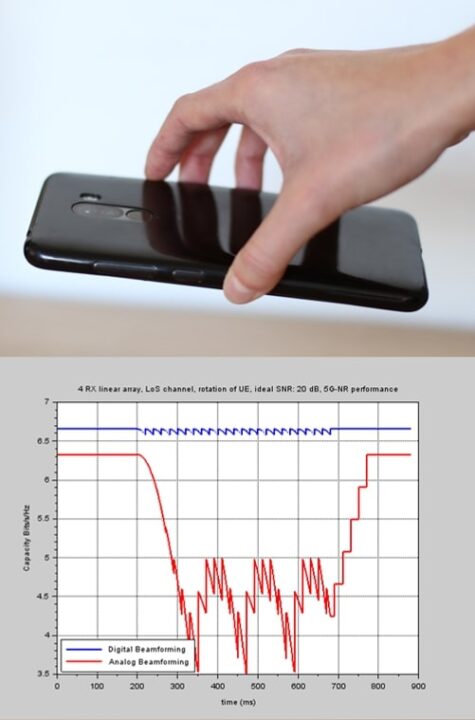What about the future? What are the new applications? And can we really use this to communicate with exoplanets?
Wouldn’t 4G be enough for me? Is 5G just a hype to get me to upgrade and spend more?
The smartphone is in your pocket or on the table. Suddenly you hear a buzzing sound, you pick up the phone and check the chat message you received on your device. On average, a person does this procedure 250 times a day according to a recent study!
This pick up the phone scenario is one of the trickiest situations to handle when using mmWave radio frequencies ; the communication between the mobile device and the base station is done using antenna arrays and beams. During the time you pick up the phone from the table (it takes roughly 0.5 seconds) the communication direction between the antennae in the smartphone and the base station changes a lot, thus in order to maintain the communication with the base station the processor in the device needs to perform beam-tracking.
In traditional mmWave radio system solutions using analog techniques, the beamforming (signal combining) is made in the analog domain close to the antennae, using phase shifters, and a combined signal is fed to the digital processor performing the beam-tracking. Since the processor only sees the combined signal, it needs to guess how to change the signal combining once it recognizes that the received signal strength has started to deteriorate. If the direction towards the base station changes very quickly, the beam tracking will always be lagging, with the result being that the device will not be able to receive the signal from the base station and hence not be able to transmit the signal in the right direction to the base station. Very low data rates (causing lagging), or even a dropped connection, is the result you will see on your smartphone.
Using a mmWave digital beamforming solution, the beamforming (signal combining) is performed in the digital processor after the digital processor has estimated the direction of the incoming signals. Using optimized beam-tracking algorithms, implemented in the processor, the signal can still be tracked even in this challenging scenario, and the performance will therefore not deteriorate as in the case using analog beamforming.
BeammWave has developed smart algorithms, optimised for a sustainable and scalable digital beamforming solution, thereby handling all kinds of challenging scenarios and minimizing the risk of lagging and performance degradation when the device operates using mmWave communication.

Did you know that people typically check their smartphones over 250 times per day? 80% check their phone when they wake up, 70% use their phone when in the restrooms and 40% look at their phone when driving despite it being illegal in most countries.
From such data one can understand that with more than 6.6 billion smartphone users in the world, looking on average 250 times a day on the smartphone, the way one can hold the phone may be a gigantic issue.
Regardless of whether you are standing, sitting, laying down or jumping you expect the device to have contact with the Internet so that you can use your favourite application whenever you desire.
For communication on radio frequencies below 6 GHz, i.e. the radio frequencies used in 3G and 4G today, a traditional antenna design with one or a few antennae, mainly at the top of the phone, is sufficient to handle all kinds of weird ways to hold a mobile device.
The introduction of communication in the mmWave radio frequency range in 5G, giving a tremendous increase of capacity in the network as well as enabling VR and AR applications requiring Gb/s data rates, comes with some challenges for smartphone applications. For instance, putting a finger on the antenna may drop the radio signal strength 100-1000 times (20-30 dB) so even a world class single antenna design placed at the top of the smartphone may not be sufficient. Also, if you are lying in your bed streaming your favourite series and having the phone in landscape mode, your hand will block the single antenna. Therefore you need a multi-antenna solution, not only to direct (beamform) your signal towards the base station, but also to have a sufficient number of antennae that are not blocked by your hand regardless of how you hold the smartphone!
Classical multi-antenna design for mmWave in handheld devices is based on distributing a number of antenna panels using analog beamforming in the phone. This is a very bulky solution, restricting the number of panels to 2 or 3 (placed at the top and on one or two of the sides). However, this will still not solve the hand blocking problem for all of the ways in which you can hold the smartphone, leading to a risk of a bad connection causing lagging or – even worse – a dropped connection.
To solve the problem, one needs a distributed antenna approach based on digital beamforming. Instead of having 2-3 antenna panels with 4 antennae, one needs 8-12 antennae distributed around the device with the capability to operate each antenna and radio transceiver independently of each other in order to combat the hand blocking problem.
Figure text: (A) shows a traditional mmWave solution for smartphones, with 3 antenna panels, each having 4 antennae. When the phone is in landscape mode, 2 out of 3 antenna panels are blocked giving bad signal quality in many directions (blue colour).
(B) shows BeammWave’s digital beamforming solution with 12 RF chips (i.e. 12 antennae) distributed around the phone. In landscape mode there will always be sufficient antennae which are free from hand blocking thereby giving good signal quality in all directions (red to green colour).
BeammWave understands all aspects of the mobile device challenges with mmWave communication and can deliver a sustainable, high performance, scalable digital beamforming solution that is optimised for handheld devices, thus making it possible to maintain a high speed connection to the Internet regardless of how you may want to hold your smartphone!
Innovation is the strangest mix of slow and lightning fast. The slow part is all the tedious research done in labs and at universities, the hard (and slow work) of specifications, and the macro trends building persistently. These are all necessary enablers, but are for the most time not recognized as groundbreaking inventions, even if they sometimes render a Nobel Prize decades after they were done.
The missing part, and what we often perceive as the innovation that moves at the speed of light, is when the application is added on top of the new technology. This allows the full power of the underlying technology to be productive and generate a benefit for its users. The real trick here is to get the timing right and, as always, understanding the economic drivers and prerequisites for success.
If we focus on the use of mmWave in 5G, all the fundamental research and specification work has been done and we now have a VERY potent technology at our disposal. 5G has a few bold promises with “endless” capacity, “no” latency and “fiber like” speed. This enables innovations like remote surgery, remote control of different types of vehicles, industrial automation, virtual presence, etc.
BUT none of the above applications will be drivers of 5G. They will (almost) all happen once mmWave is widely deployed and available, but for none of them, on an individual basis, will it make financial sense to take the full, or even part, of a network investment. This is nothing new since it seems like every amazing and promising technology is always looking for the “killer app”, the one application that on its own can justify the wide deployment of the base technology. Once this is done and the technology is deployed, there will be an avalanche of innovative use cases and devices being built. I believe that many of us have been in the situation where we have tried to orchestrate a technology liftoff by trying to use the collective power of many different applications and, unfortunately, I believe there are almost as many of us who have failed, myself included. It simply seems to be a universal truth that a single killer app is needed.
This is probably also the explanation to the phenomena that so many have observed over and over again, namely that promising technologies always impact the market later than expected but once it happens the impact is way bigger than anyone would have dreamed of. It takes something to start an avalanche, but once started there is nothing stopping it!
So, what is the killer app for mmWave and 5G?
I will say…the smartphone!
But wait a minute, that was the killer app already for 4G! Yes, that is true … and your expectation of that killer app is an increased data bucket at a lower price. The operator needs a constantly lower price per bit sent and that is not possible without new technology and new frequency bands like mmWave. I also know that BeammWave’s digital beamforming solution will be one of the key enablers for making mmWave in 5G happen for the mass market.
Many believe the main reason for introducing communication in the mmWave frequency range (24 GHz and above) in 5G-NR is to allow for use cases requiring Gb/s such as VR or AR use cases. It is true that such use cases require a lot of bandwidth not existing in current sub 6 GHz frequency bands, and it is also true that 5G will be an unprecedented innovation platform for the coming decade, however the main driver is the need for more capacity in the radio spectrum.
Data consumption explosion over cellular is expected to grow exponentially and hence there will be a time, predicted to be around 2023 starting in Mega cities, where communication over the sub 6 GHz frequency bands start to reach its capacity limits.

The only way to support such data rate explosion in the world’s cellular networks is to utilize the mmWave frequency bands. In order to solve that, all wireless devices such as smartphones, both high end and low end, and even IoT devices, need in the near future to support communication in the mmWave frequency band. Therefore, mmWave communication, with all their challenges such as shorter coverage and high sensitivity for blocking radio signals by hands or other obstacles, need to be solved by a sustainable and scalable digital beamforming solution optimized from all angles of the system, not only focusing on the radio front end parts, which typically comes into one’s mind talking about mmWave radio communication, but also things such as:
– System architecture including radio and baseband interface
– Digital beamforming algorithms
– Mobility and handover procedures
– Performance and power consumption
BeammWave knows the entire system and delivers the digital beamforming architecture enabling the mass market for mmWave communication in handheld devices opening up the almost endless capacity existing in the mmWave frequency band!